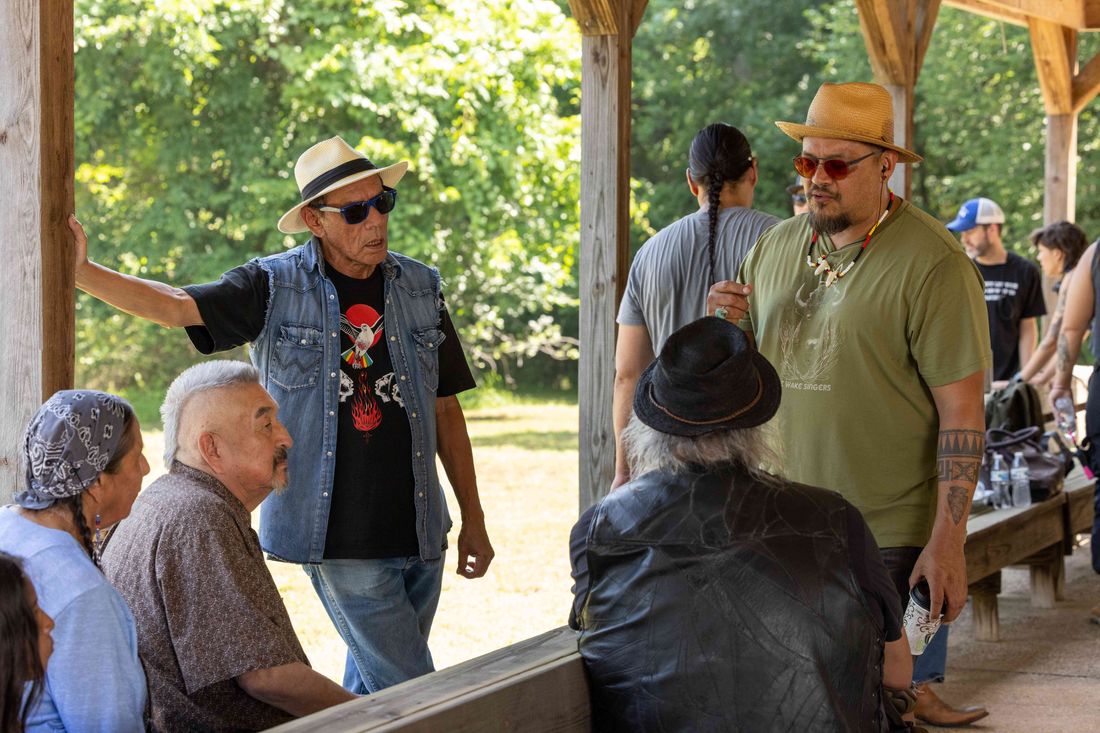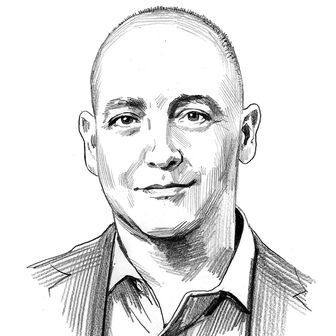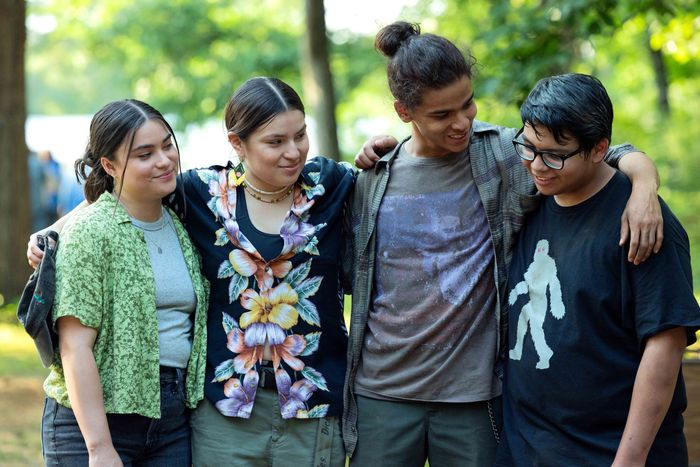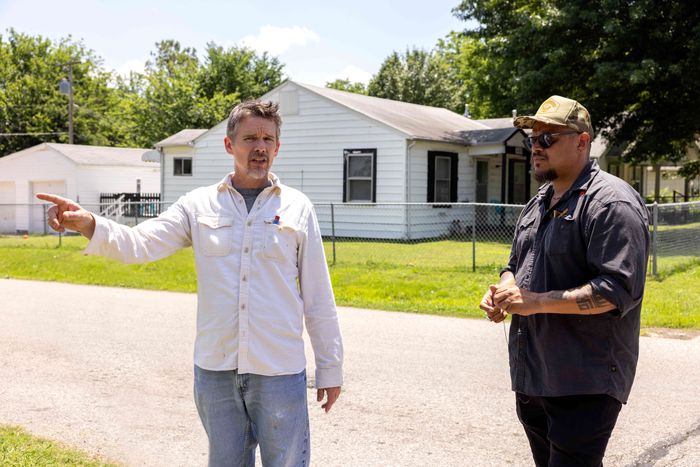
Sterlin Harjo has dug a lot of graves in his life, but this is the first time he had to dig one for a TV show. The co-creator and executive producer of the groundbreaking series Reservation Dogs — the first American series about Native Americans comprised almost entirely of Natives in front of and behind the camera — just finished a three-season run on FX, garnering critical acclaim and a small but devoted following as much for its sardonic humor and formal experimentation as for its focus on a community long ignored by Hollywood. Fittingly, for a show that often included playful meta-acknowledgments of itself as a work of art, the story ended with a funeral.
A Seminole/Muscogee Creek filmmaker from Holdenville, Oklahoma, Harjo has picked up a shovel many times, most recently to bury the nephew of a family friend who died in a motorcycle accident. “We showed the finale last week at the River Spirit Casino Resort, and I saw this woman,” he says. “I told her, ‘This episode is representative of every time I’ve been in a situation where someone passed, but there were a lot of things I pulled from the last time I dug a grave. And that was your nephew’s.’ And she was like, “Ah, I wondered because I could feel that.”
This literally earthy ending is characteristic of Reservation Dogs; one of the qualities that made it so beguiling was its commitment to staying life-size. Nothing happened that couldn’t happen in life — even the arrival of a long-dead loved one or centuries-old spirit felt plausible in Okern. The show’s deadpan delivery and appreciation of irony ensured that even when characters had personal revelations or experienced tragedy, the scripts and direction treated the events with a wry, knowing smile. In an industry where an Indigenous actor’s main job for decades was to support a white lead actor and occasionally say something gnomic — a small step up from the previous go-to job, riding in on horseback to shoot an arrow at John Wayne — it was a glimpse of an alternate universe where talent and versatility win out.
“It was a beautiful thing,” Harjo told Vulture in a wide-ranging conversation about the show’s legacy and style. “My life has changed. A lot of people’s lives were flipped upside-down.”
How do you feel, now that it’s over?
One of the most beautiful things about ending it is that it does continue on, but we don’t know what will happen, which is kind of a blessing. Also, for me, it was a coming-of-age. And you can’t keep coming of age. You have to just be of age at some point.
As the show got closer to the end of its run, I saw people online trying to predict what would happen for all the characters and where the story would go. I kept thinking, this isn’t Game of Thrones.
For me, the show is reflective of life, and the story’s about a community. We’ve watched this world of Reservation Dogs grow from four kids to a whole community that are Reservation Dogs. That was always the intention.
The finale’s a perfect way to end it. Everything you see in that is what we do in my community: The digging, the fasting, the hanging out, the laughing, the reconnecting, singing songs when you’re transporting the deceased person from one place to another — all of that is very real, and I think the audience will feel that. I’m not trying to force anything really big; I tried to keep the storytelling of the finale just like the rest of the show. But I knew I wanted a lot more characters in this last episode, so I brought everyone back. I’m a really big Robert Altman fan.
Tell me about your love for Robert Altman.
There are a few filmmakers who highly influenced this show, and Altman was one of them. When Chad Charlie and I wrote it, I was thinking, How do I handle bringing all these characters back? I told Chad to watch Robert Altman’s Nashville because I wanted to bring in multiple characters and have scenes happening in the background and foreground, and I wanted to use zoom lenses.
What did you achieve by shooting this episode the Altman way?
There is a warmth. It’s a very rounded-out episode, not hard-edged, almost like a hug, you know? It feels like a way to hug the audience, and take them along, and show them where everyone’s going. When Elora and Bear are hugging, and she says, “I’m gonna go, but it’s gonna be okay,” that makes me cry every time. She’s trying to convince herself, and she’s also truthful in telling him that. She believes it’s gonna be okay.
It speaks to viewers, too. They’re losing the show.
When Bear is first sitting there with Elora, and he goes, “It’s weird, right? He was here, now he’s not,” it’s like the show, right? It’s gone, but it’s not gone.
Have you dug graves?
Yeah. I remember being a young man, and then all of a sudden there was a point where I was digging graves. I was like, I want to dig this grave now.
One of the most beautiful things when we dig a grave is how funny it is. We always have so much fun doing it and joking. It’s grieving. You get in there with your cousins and brothers and uncles and dad for the person that you loved. You’re sweating and putting every ounce of love into that hole, knowing that, in honor of them, you’re gonna dig their final resting place. And you laugh, and you cry and get upset, but ultimately, you love, and you have fun. I’m really grateful to be a part of a culture that can recognize the need to grieve and be together.
You don’t have to go to extreme places to tell stories that connect to people. They’re right here in front of us. That was our intention, to tell these stories that are right in front of us from our community and show in turn how alike we all are as human beings. Even though we’re Native, everyone can identify with what these characters are going through. That was the goal of this show.
Can we talk about the character of Fixico? Early in the series, I never could have imagined how important he would become. Why did you decide to make him the backbone of the final stretch?
To show what community means and how it operates within Native culture, it made sense to take a marginal character and watch him become this emotional, dramatic device through the end of the last season. It shows how we treat our people and how community works. Everyone’s a part of his story and has a role, and if you remove one piece of that, it disrupts everything. You have to fill in that hole and figure out who’s taking the spot.
I loved my great aunt. She was my grandma’s sister. We called her “Doe.” She was the person who took care of everyone: She made the best food; she came over and cooked you a great meal. She was the center of our family. When she passed away, I thought, Who’s gonna take this spot? We don’t have that person. I went over to her house where her daughters and sons and grandkids were all grieving but also eating, and people were bringing food. All of my aunt’s granddaughters, my cousins, without breaking stride, without missing a beat, took her spot. They were cooking, taking care of people, and making sure they were okay. They learned that by watching her and being in her presence. That’s also something that happens in “Mabel.” That episode is based on what happened when my grandmother passed. I took what I saw and transferred it to Willie Jack and Elora. You see how, without talking about it, they start taking care of people. I wanted to show that.
And it all connects back to Fixico. The characters have all been to these funerals. They’ve all dug graves for people. When Fixico passes, it illustrates how this all works and how they’ve gotta just step up and do it.
The grave-digging scene is also a chance to put a lot of Native American actors together and let them be funny. You do it a lot on this show, and it’s not something that happens often, even for individual actors. Wes Studi was great as the Sphinx in Mystery Men, but roles like that are rare for him. More often he’s cast as a stony-faced badass.
I remember telling Wes that I wanted to make a comedy for him and write him a funny part. I knew a lot of guys like him. I knew how funny they were, and I kept thinking, How is it that no one has let them do that on screen? These actors were really funny, and they were waiting, sometimes for decades, to be cast in a comedy role.
In the show, Fixico started the Nards youth summit. He had everyone join hands and said they were the first people to walk the land and then the whites took it. Then he had them face different directions and choose which direction to go in. What does that description make you think about? Particularly the last part, about choosing which direction to face?
To me, it humanizes a medicine person and a spiritual leader in a community. Throughout history, we’ve been painted in a false light to fit this westernized view of who we are. And no more than how spiritual leaders and medicine people have been portrayed in Hollywood, which is very fake-mystical — I see the future inside of people, or whatever. In our communities, these spiritual leaders are regular people. They’re wearing blue jeans and Oklahoma football or baseball caps. They’re not pretending to be something they’re not, and that’s what makes them so important. They are us, and you can identify with them. They don’t pretend to know everything. That’s the difference between European religions and Native ways of life and spirituality. We don’t pretend to have answers. We just try to do things the way we’ve been taught and have faith in the fact that that’s going to be good enough.
That scene was about humanizing Fixico as someone that can make mistakes and whose age is getting the best of him. Also, that happened to me one time! There was a person who fancied himself a medicine person, and he was praying and had us all hold hands. He was doing a bit of a grandstanding thing, where he had us moving in different directions. It was very confusing, and we were all wrapped up in a ball at the end of it. I recreated that on stage one time in Portland, Oregon, with my comedy group, the 1491s. We did this event the day after Prince died where we came out as different characters; I came out as an old man, and I had everyone, including the mayor of Portland, stand up in the Portland Art Museum and hold hands. I did this prayer as an old man in a wig, and I had them move in different directions where they all ended up laughing in a big, confusing mess!
Was the character of Fixico named for anyone in particular?
No. I have a lot of friends that are Fixicos. Fixico is like Harjo. We have these Muskogee last names, and they’re descriptive warrior names: Harjo translates to “crazy in battle,” and then Fixico is similar — it’s like “heartless in battle” or “heartless” as in “have no fear.” It’s a common name, so I used it for his character.
A lot of people want catharsis and closure when a show is nearing the end of its last season. You don’t do that. Episode eight is a low-stakes jailbreak, structured in flashback as a police investigation, and spends a lot of time with Graham Greene’s character Maximus, who’s only made two other appearances. And the penultimate episode focuses on just two characters, one of whom — Elora’s father Rick — the audience is meeting for the very first time. What’s the thinking behind that?
If you watch Altman’s The Long Goodbye, which is one of my favorite films, for the first 30 minutes you are watching a man getting harassed by his own cat and needing to get cat food. It has nothing to do with the crime or what unfolds. That can be jarring, but it works really well. That’s the way this show is set up structurally: You don’t get your hand held through everything. An episode stops, and you’re somewhere else when it picks back up, and things have happened in between. That allows for audience participation and imagination to fill those gaps. I remember Jim Jarmusch saying in an interview, “A lot of filmmakers are concerned with someone getting to the bus stop and taking the bus from point A to point B. I’m more interested in what happens at the bus stop while they’re waiting.” That’s something I truly feel and implement with this show. It’s about the moments in between and how seemingly mundane things can carry really great and profound meaning.
Did you ever worry that if you were too withholding or clever or elliptical, you’d confuse people, or frustrate them?
I know an audience will stay with me in certain ways, and I also know an audience will get some sort of dopamine release when they don’t know exactly where they’re at, but then it all starts to line up. There’s something in that; I don’t know what it is, exactly, but it felt right. And it also felt like Native storytelling. It felt like the stories I heard growing up, how they told stories around a kitchen table. My family was really good at telling the most mundane story, but it’s how they told it that made it so exciting. That’s what I wanted to capture.
Was there a meaning or moral in those kinds of stories? Or was it mainly about the experience?
There was always some meaning in there. I think that that’s true for all people, but with Indigenous people for sure. We have these stories we call “trickster stories,” and they’re always so confusing. Sometimes they’re really strange. But there’s always a meaning buried in them. You’ve gotta figure it out. When my family would tell stories like that, they were always lessons about things. It doesn’t wrap everything up with a bow. It’s up to you to figure it out and pull meaning from it. In a way, that’s how this show operates. We don’t hit anyone over the head. We don’t force them into corners.
There had to be times, though, where you thought, What we’re doing, at this moment, is so important that we can’t be too subtle or the whole reason for doing it might get missed. What did you do?
Sometimes we’d get more pointed. When Hokti says, “What do you think they tried to do when they were trying to destroy us? They were coming after our communities because they knew if you break the community, you’ll break the individual.” That’s one of the more pointed lessons in the whole show. Every now and then you can play with that. You really have to earn a moment like that, a moment when you can go, “All right, we’re going to step back and tell a story about boarding schools,” like we did in “Deer Lady.”
You mentioned Robert Altman earlier. But I wondered if you had Richard Linklater, probably Altman’s most devoted disciple, in the back of your mind as well?
He’s probably one of the bigger influences on the show.
Were you making it official by bringing in his frequent collaborator Ethan Hawke in the ninth episode?
Right! We even named him Rick! Ethan was so great. I was in awe of him. He was so gracious and took the job so seriously. He loved the show already, but when an actor of that stature comes in like that, it inspires everyone. It lets us know that someone who’s done such great work believes in what we’re doing. He didn’t have to come. He probably didn’t get paid great compared to what he’s used to. But he made it happen. When I was talking to the writer’s room about the idea of that episode, I said, “I want this to feel like Before Sunset: two people walking and talking.” Obviously, I shoot it like that as well.
Filmmakers like Altman and Linklater and Jonathan Demme deal in human emotion, and truth, and naturalness. They know that drama doesn’t have to be big. When I watched Dazed and Confused, I felt like that was my life as a high schooler. We played football. It was the most important thing. We went to the lake, and that’s where we partied. For a lot of us, that was all life was ever gonna be. That was the highlight! A lot of times I thought, This is it. This is what I’m here for.
Linklater deals with that. He deals in life. He deals in real life in most of his movies. When I saw Boyhood, I was blown away. Just blown away! I felt like I’d seen something I’d never seen before, but also, so much of it mimicked my life, and my daughter’s life, and her mother’s life, being raised by parents who weren’t together. The whole time my daughter and I watched Boyhood together, our mouths were hanging open because there were many similarities to our lives. I like to play Guy Clark’s “L.A. Freeway” on the guitar. My daughter told me, “That song will always remind me of you.” There’s a moment in Boyhood where Ethan Hawke’s character is camping with his kids and you just see a silhouette of him playing “L.A. Freeway” on the guitar. When that happened, I was like: Man. Richard Linklater tapped into all of us.
That episode is also interesting because earlier in the season, Elora discovers that her biological father is a white man. That doesn’t just feel like a plot point. It feels like a statement: We’re all part of the same family.
We like to pretend we aren’t, but we are. I’m half-white. I learned as much from white stories as I did from Native stories. The world’s a better place if you think of us as all together. The world’s a better place if we don’t think of ourselves as separate and siloed away. We learn from each other. We get it; there’s a lot of pain, a lot of hardness, but there are also really good white people.
I was talking to Ethan Hawke recently about some old literature he was reading. There were some writers who were very strongly against the Trail of Tears, who were activists against it. You don’t always think about that — you think about Andrew Jackson and how he forced us to move from Alabama and Mississippi to Oklahoma and the territory. You don’t think about the people who were fighting to let us keep our home. I think it’s important to always remember and acknowledge the people on the other side of situations like that: the people we love, that are close to us, that we learn from, that are in our community. Characters like White Steve and Kenny Boy are in the community, you know? That’s why Kenny Boy gives that moving speech about community at the end of episode eight. Because he’s a part of it.
He also shows up at Fixico’s grave with an armload of shovels!
Right! He comes in the clutch, and he’s inspired. He’s even inspired by Maximus to get a mohawk!
If you had to pick one wish to come true as a result of having done this show, what would it be?
My wish is that every writer on this show, every actor on this show, every person on this show moves on and makes something really brilliant. I hope everyone gets an opportunity to tell their stories. There are so many great stories. And that’s part of what Reservation Dogs was about. That’s why we played with genre, that’s why we played with styles: to show people how diverse Indigenous stories can be. We’re not just one thing, we’re a lot of things. I hoped to illustrate to network executives, and to the world, that we have all kinds of stories to tell. And I hoped to make room for other people to do their own shows. We have to continue this.





